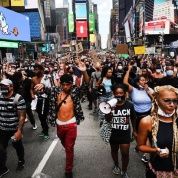The year 2021 is drawing to a close, leaving untouched American structural racism, a legacy of the slave age that capitalism preserves to ensure the reproduction of social inequalities, which have been exacerbated by a pandemic that continues to hit workers in various ways.

RELATED:
114 US Congressmen Urge Biden to Restore Engagement with Cuba
In Minnesota, for example, the rate of coronavirus infection in citizens of African descent has remained between 25 and 30 percent since the beginning of the pandemic, even though this population group represents only 6 percent of the state’s inhabitants.
In New York, the death rate of Latinos produced by the virus is 1.6 times higher than that of Caucasian citizens, who have greater access to health services and better working conditions to prevent infection.
On May 25, 2020, 46-year-old African-American George Floyd was killed by former Minneapolis police officer Derek Chauvin, who arbitrarily imprisoned him and knelt in his neck until he died asphyxiated.
The crime was recorded by 17-year-old witness Darnella Frazier and replicated on the Facebook social network by the Black Lives Matter (BLM) movement, which denounces police violence and impunity for crimes against African-American citizens.
The broadcast of the video generated the largest protest movement in U.S. history in terms of intensity and geographic scope. According to data from Princeton University and Armed Conflict Location and Event Data Project (ACLED), over 7,750 BLM-associated protests occurred in 2,000 locations in the country’s 50 states. Another study published in June 2020 by Civis Analytics revealed that nearly one in 10 Americans participated in BLM demonstrations.
But how did these protests achieve such a reach in a country with institutional racism?
Currently, social media platforms provide a space for people to connect with others and express their opinions in a virtual public sphere, where citizens can collaborate to negotiate social understandings. When connected in this way, communities can engage in meaningful conversations around global crises and create counter-narratives.
Along with the development and mass dissemination of smartphones, this possibility has created conditions for the exercise of citizen journalism, by which persons not affiliated with traditional media or journalism training assume the role of creators and distributors of news. In this context, community members take global crises into their own hands and report their perspectives to a large audience as a form of social activism. This new reality has caused many citizens to consume more news on social networks than in the traditional media as an alternative way to access other perspectives.
Newberg students are planning a walkout today in solidarity with Black students.
— Ryan Clarke (@RyanTClarke) December 16, 2021
This as the school board continues to defend a ban on political symbols after originally targeting Black Lives Matter and Pride, and 2 of the board members who support the ban face potential recall. pic.twitter.com/NgbjdKA1fm
In 2019, a study by Ofcom —the regulatory institution for communications services in the U.K. — revealed that 49 percent of the British population receives their news through social networks. Meanwhile, the Pew Research Centre reported that 55 percent of U.S. adults read the news on these platforms, a figure that represents an increase of eight percentage points over the previous year.
This reality is very beneficial for marginalized communities members, such as the Black people, who almost always find their voices silenced or distorted by the traditional news media. When addressing the anti-racist protests in London in 2011, outlet The Sun positioned the police and white viewers as terrorized, oppressed, and innocent, and the Black community as mindless thugs causing violence and destruction.
On social networks, there are also distorted publications about this subject. On Facebook, for example, one user falsely claimed that the government identified the BLM as a terrorist group. Another post showed its activists beating white elderly citizens. This action was later discredited by news verifiers who found that the crimes' perpetrators did not belong to the movement and the content had been online for many years.
Despite this situation, several experts agree that BLM activists have known how to take advantage of the communicative opportunities offered by digital social networks. This movement has employed one of the most effective strategies to make content visible: the production of hashtags, which brings together coincident perspectives and counteracts the dominant frameworks in these platforms.
The words "Black Lives Matter" first appeared online in July 2013, following the acquittal of police officer George Zimmerman for the murder of Black teenager Trayvon Martin. In response to the news, Facebook user Alicia Garza wrote, "Black people. I love them. We love each other. Our lives matter. Black lives matter."
The phrase was first used as a hashtag by activist Patrisse Cullors and shared by immigrant rights advocate Opal Tometi, who supported the movement by creating Tumblr pages to spread related news. Despite the fairness of the causes it defends, the BLM has been criticized by ultra-right groups, who claim that this type of activism in social networks is a redundant and not authentic effort to fight for social reform.
The work that the movement has done, however, has proven to be innovative, as the protests that arose from the social media exchange resulted in pressure on the American judicial system to ensure that Chauvin, the murderer Floyd, was arrested and sentenced to 22 years in prison for his crime.
Citizen journalism and social media activism have demonstrated the ability to make visible the global crises silenced by traditional hegemonic media. The practice shows their indissoluble relationship. While social media activists would lack evidence without citizen content, citizen content could not be shared among so many users without social media activism.
CELAC was born 10 years ago as a mechanism to face U.S. interference. pic.twitter.com/fC8zKNk8w9
— teleSUR English (@telesurenglish) December 2, 2021